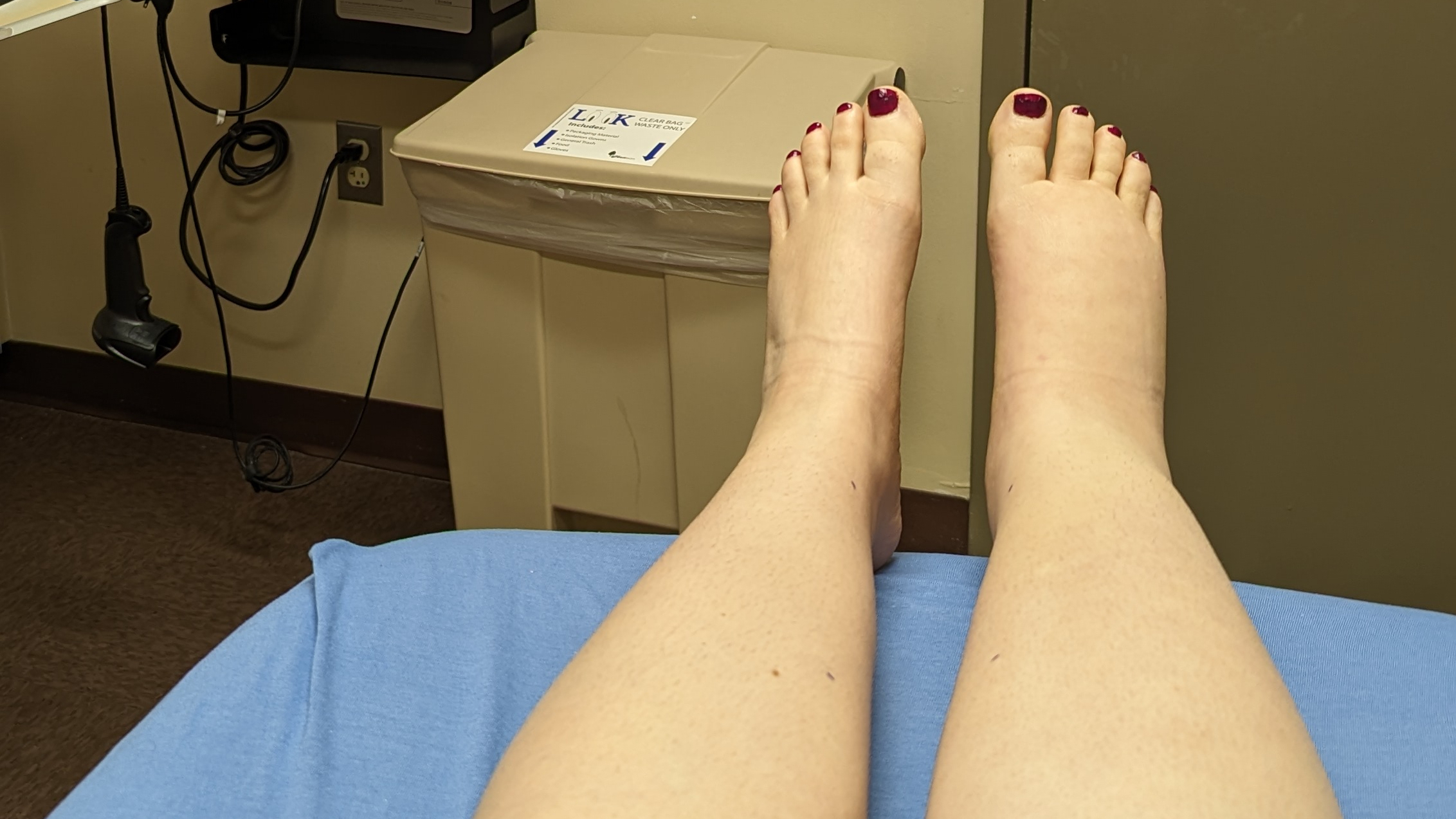Submitted by Barbara P., August 2012.
 At 61, I’m in that group of Baby Boomers who’ve had primary lymphedema for an extraordinarily long time (at least half a century, in my case) and couldn’t get a proper diagnosis and treatment for decades. I don’t even know how long I’ve had it, but I have no memory of ever seeing the outline of the bones, veins and tendons in my lower extremities until well after I started CDT in the fall of 2002…yet I’ve always had slender hands, wrists and arms.
At 61, I’m in that group of Baby Boomers who’ve had primary lymphedema for an extraordinarily long time (at least half a century, in my case) and couldn’t get a proper diagnosis and treatment for decades. I don’t even know how long I’ve had it, but I have no memory of ever seeing the outline of the bones, veins and tendons in my lower extremities until well after I started CDT in the fall of 2002…yet I’ve always had slender hands, wrists and arms.
The terrifying, painful, disfiguring and progressively disabling problems whose nature was confirmed in September 2002 (after I had cellulitis that August) struck one afternoon in December 1961, with a very painful (but not swollen) right ankle, which, the next morning, was not painful in the least…but was extremely swollen, with swelling and blotches from foot to shin. I could walk–heck, I could even run–so I told no one, but simply got dressed and went to school. Besides, my mother would have panicked if I’d shown her the leg. My paternal grandmother and my father’s older brother had the same problem, unnamed at that point, and I knew how Mom would react. In purple tights and white galoshes, off I went through the foot of snow we’d just had, to my elementary school a few blocks from home. (I have no idea how I kept my parents from seeing that leg in purple tights, but I had already learned to be the family stoic as my younger brother was a source of great concern to them.) One of my teachers saw the leg and called the school nurse, who took me aside during gym class and asked how it felt and if it hurt (“no,” I answered honestly) and if my parents knew about it (“yes,” I lied). She let me go back to our game of soccer baseball, which, as its name suggests, involved kicking a soccer ball around a baseball-diamond-shaped field.
When I got to our sidewalk after school, still in purple tights and white boots and surrounded by snow, my mother finally saw my right leg. I think the whole block heard her scream. I was more embarrassed than anything else. Our doctor was baffled almost beyond words, and the local orthopedist, when he x-rayed the leg on his return from Christmas vacation two weeks later, was equally confused, suggesting a possible hairline fracture as the source of the swelling, even though I’d been able to walk and run. I knew he must be wrong, for three years earlier, I’d had such a fracture in my right elbow and couldn’t move or use the arm at all. Since that time I’ve had a similar knee injury, with the same result, so if you think I might have fractured the ankle, I’ll stake a paycheck on your being wrong.
Over the next few months, the swelling receded to a considerable extent, but that summer I had my first experience with the hideous skin infections we know too well! At one point all ten of my toenails were removed…without anesthesia. I don’t remember much pain, but I do remember my mother’s wincing, grimacing and other embarrassing signs of squeamishness. After that, the swelling–still only in my right foot, ankle and lower leg–became a constant, unwelcome companion, and I remember realizing that even though my left leg, foot and ankle weren’t swollen, neither the right nor the left had ever compared with my arms; they’d never had much shape, but had looked like “piano bench legs,” as Mom said. One day in my early teens I noticed the outline of the left fifth metatarsal tendon (above the pinky toe), but after that, even that disappeared. By my first year at Smith College, in the fall of 1969, the swelling had migrated to my left leg…which I thought could be Someone’s way of getting back at me for wishing that, if the right foot, ankle and leg wouldn’t shrink, maybe the left ones would expand, so at least they’d match! :-p
Oddly enough, as a graduate student at Yale in the mid-’70’s, I had a doctor who told me that the swelling and infections were due to lymphedema. He could spell it, pronounce it and briefly describe it…but he said, without hesitation, that there was no treatment for it. Beyond walking as much as possible, wearing good shoes and keeping my weight down, there was nothing I could do. Many years later another doctor disagreed with his diagnosis, and, since the first one had insisted there was no treatment, I gave more credence to the words of the second. It was cellulitis and my reading about it that frightened me out of acceptance. Talking with my uncle, who’d been able to get his diagnosis in the ’90’s, by which time his disease had become very severe, helped motivate me. In September 2002 I finally learned what I had, and life in compression wraps and garments began.
Yes, it’s been ten years since that started. First (October ’02) there were bandages and accessories, with skin care and time walking and on exercise bikes but no MLD except what I was taught to do myself (don’t ask why); then there were those at night and stockings, toecaps, Komprex foam, exercise (biking, walking, swimming and ice skating, my passions) and skin care during the day; then my doctor, Andrea Cheville (she was at the University of PA and I was and am in Philadelphia), told me about LegAssist sleeves and MedaBoots, which I’ve been using instead of the bandages almost every night since then. Every so often a supplier tries to send me KompreBoots, which might work for some people but give me no support or compression at the ankles, which is vital to me. My therapist and I always groan when that happens…and tell them again that I need the MedaBoots.
Since you haven’t seen my legs, here’s a progress report: I started with class 3 below the knee compression stockings (Juzo, prescription but off the shelf) and toecaps, custom made, class 1 (Elvarex; they look like driving gloves but for the feet as they have the toe-tips cut out). For my right leg the stockings were size 3 regular, and for the left, size 4 regular. Within months I was down to size 3 regular in both, then 2 in the right; by May ’03 I was in 2 in both though the left was a bit snug (I remember because I took them to my 30th reunion at Smith, and the left was tolerable but I was more aware of it than of the right). A few months later I was down to size 1 in the right, and 1 in both by the next spring. About a year after that I had to switch to size 1 short in both because the volume in both legs had reduced to such a degree that the regular-length stockings rolled up at the knees and cut off circulation, making them counter-productive. I think it was last fall that, after trying class 2 on my right leg for a while and staying with 3 for the left, I had to give up that one…and tell my therapist that I could no longer wear class 3 at all as they simply gave both legs too much compression. You should have seen the look on his face. I wish I had photographed it–he was trying so hard not to laugh or cheer! (After all, it wasn’t the World Series or the Super Bowl, and how much noise did he need to make in a treatment center?!)
I’m sitting here in my size 1 short Juzos with toecaps and Komprex, plus light support knee highs from Footsmart (great website for shoes, stockings and other items for foot and leg problems: www.footsmart.com), for a little extra compression and to protect my very expensive Juzos; as for shoes, I’m in very good low-cut hiking shoes from L.L. Bean. I’m delighted, but not satisfied. Even though my lymphedema is hardly noticeable now to anyone other than me, my doctor and my therapist, I despise it. No one should have to go through a lifetime of being blown off about a disabling, disfiguring, painful, progressive and potentially deadly disease, and there’s still so little known about it and so little money and effort put into training doctors and scientists to find a cure or even a true remission for it. I know there are other people out there who are told, as I was for so long, to “just live with it”–without being told what “it” is.
Advocacy, research, public and professional education, and patient and family/friend support and education are absolutely vital. Some people wonder why I’m not more patient about lymphedema now. The reason is simple: I’ve had to spend, or rather waste, too much time being “patient.” The same applies to many other people: I had a colleague whose mother died from improperly diagnosed primary lymphedema (she was told for years that she had rheumatoid arthritis), and I know of two members of my paternal grandmother’s family who also died from it. As I’ve said in reference to other problems that have been with us as a species for a long time, we’ve been too nice too long.
Submit your story to the Lymphie Life! Use the contact form here to share your personal story of living with lymphedema, and, with your permission, it’ll be posted on the website.



Leave a Reply